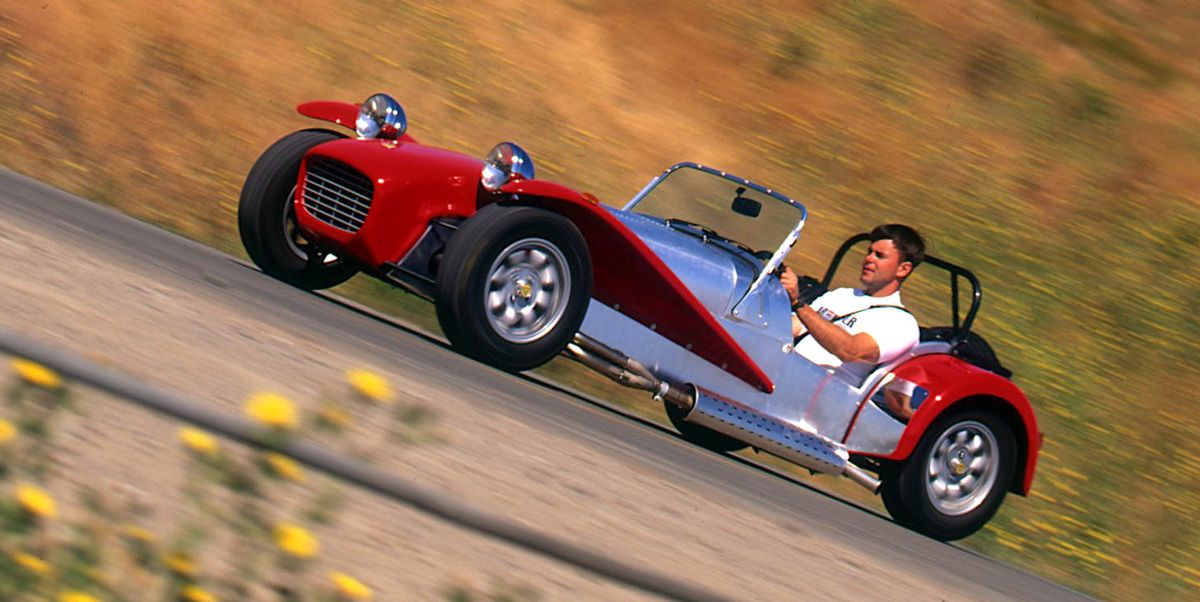From the April 1997 issue of Car and Driver.
Various old-fogy automotive wankers are forever lamenting the demise of rattletrap roadsters—the kind that were around when the average guy could tell you who Neville Chamberlain was. Well, cheer up, graybeards, a few of these old-timer cars are still around.
Caterham Cars of Caterham, England, produces a variation of the original Lotus 7 that first appeared in 1957. When Lotus decided to stop producing the car in 1973, Caterham purchased the rights to produce the tiny English roadster. Today, Caterham offers two models for sale in kit form in the U.S.: the Supersprint and the Classic SE. Both cars use 1.6- or 1.7-liter carbureted Ford Cortina-based four-cylinder engines that date back to the Sixties.
The Supersprint has an independent rear suspension; the Classic makes do with a solid rear axle just like the original. It also eschews bucket seats in favor of a bench that stretches across the cockpit—just like the original—with only the transmission tunnel and belts left to hold the driver in place. Plus, the smaller tires of the Classic are dwarfed by the car’s rear fenders. The aluminum covering the frame was polished (you can get it painted), and the fiberglass fenders and the nose cone were painted red.
In 1982, Caterham lengthened the car by two inches to increase its legroom, but it’s still extremely tight inside. To get into this roadster, you first stand on the seat and then support your body on the roll bar and side sill as you slide your legs under the steering wheel. After a few tries, it becomes relatively easy, but there’s little room once you’re in there. Thankfully, the parking brake is located under the passenger-side dash so it doesn’t intrude.
Footroom is also precious. In fact, this tester had to drive barefoot because his size ten-and-a-half sneakers simply wouldn’t work—depressing the clutch meant applying the brake, too. But being cramped is part of the fun, right?
The car weighs just 1124 pounds. Weight is the enemy of performance, and this car’s light weight makes for a truly energetic drive. Our test car’s 100-horsepower 1.6-liter motor did the 0-to-60-mph routine in 6.5 seconds, which beats both a Mazda Miata and a BMW Z3. The engine pulls cleanly right off idle, and a proper exhaust bark bellows right below your left ear. The only clue that there are carburetors metering the fuel flow is the appearance of two air cleaners poking through a hole cut in the right side of the hood—or should we say “bonnet”? Besides that, the engine ran just as smoothly as a fuel-injected one during our fair-weather test. Skidpad grip is impressive at 0.91 g, but a tendency to lock the right front brake stretched out stops from 70 mph to 220 feet.
My experience with old sports cars is limited to a couple of elderly Triumphs I once considered buying. After just a few miles in either the TR3 or the TR6, I walked away amazed that I was able to drive both for short trips without having to walk back—the cars felt ready to fail at any moment. The Caterham definitely looks like a vintage car, but somewhere along its evolution, it has lost that rattletrap feel. You can accelerate hard, dive into corners, and mash the brakes without fear of imminent breakage. You find yourself hustling around and grinning a lot in this kooky-looking machine.
The four-speed gearbox is pirated from a 1970s-vintage European Ford Escort. It’s perfect for the car. The lever is tiny—smaller than a Miata’s—and snicks into gears with an enormously satisfying mechanical feel that so few cars offer these days.
Even though the car starts as a kit, you’d hardly know it when driving. The frame is strengthened by aluminum honeycomb panels that are riveted to its sides, and the result is an impressively stiff car. No rattles or squeaks accompany hard driving, which speaks volumes about the car’s quality.
The kit for the car pictured here, which includes the engine, costs $23,500. A Caterham dealer will put it together for you for $2500. Doing it yourself is said to take about 50 hours. A 1.7-liter assembled Supersprint costs $33,000. Of the 700 Caterhams produced each year, only 50 make it across the pond, and that has created the current 16-week waiting list.
Did we have fun driving the Classic? Yes, but probably not as much as guys old enough to remember Neville Chamberlain.
Specifications
Specifications
1997 Caterham Classic SE
Vehicle Type: front-engine, rear-wheel-drive, 2-passenger, 2-door convertible
PRICE
Base/As Tested: $26,000/$26,000
ENGINE
pushrod 8-valve inline-4, iron block and head
Displacement: 98 in3, 1599 cm3
Power: 100 hp @ 6000 rpm
Torque: 100 lb-ft @ 4500 rpm
TRANSMISSION
4-speed manual
DIMENSIONS
Wheelbase: 88.5 in
Length: 133.0 in
Curb Weight: 112.4 lb
C/D TEST RESULTS
60 mph: 6.5 sec
1/4-Mile: 15.5 sec @ 84 mph
Rolling Start, 5–60 mph: 6.5 sec
Braking, 70–0 mph: 220 ft
Roadholding, 100-ft Skidpad: 0.91 g
C/D TESTING EXPLAINED
